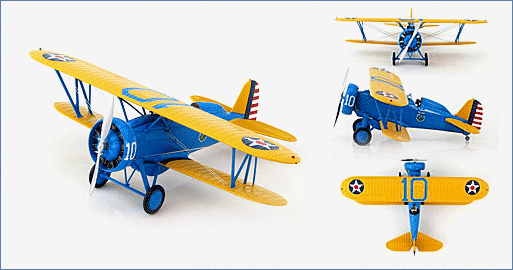Air Power Series>1:48 die-cast display model>F4B>HA7909
Boeing P-12E Aircraft 10 from "Skylarks" Aerobatic Team, Maxwell Field, Alabama 1937

General Background
In the early 1930s Boeing developed a series of biplanes designated the F4B for the US Navy and US Marine Corps but was a P-12 for the US Army Air Corps. The aircraft were first accepted in 1929 and served as the primary fighter. The P-12 was built in 6 successful variants while the F4B had 4. The P-12 was replaced by the Boeing P-26 in 1934-35 but the F4B carried on with operational duties until the Grumman F2F/F3F series completely replaced them in 1938.
The Aircraft
The Skylarks were formed in 1935 and instructed by Captain Claire Chennault of the aerial
demonstration team "Three Men on the Flying Trapeze" that disbanded in 1936. Flying the
Boeing P-12E the team learned tight formations such as loop formations, inverted flight,
Immelmans and double rolls. The highlight of their short existence came when the performed at
the 1937 National Air Races held in Cincinnati Ohio. The team consisted of Carl Storrie,
Clayton Hughes, Wilbur Aring and CO Capt. Charles McAllister. Shortly there after; the
"Skylarks" were disbanded when personnel were re-assigned.
Specifications :
| Total Produced All Variants: | 586 |
| First Flight: | June 25, 1928 |
| Role: | Fighter Biplane |
| Powerplant: | 1 x Pratt & Whitney R-1340-16 WASP air-cooled 9 cylinder radial engine, 550 hp (410 kW) |
| Performance: | |
| Speed: | 189 mph (164 kts / 304 km/h) |
| Service Ceiling: | 26,900 ft (8,199 m) |
| Range: | 369 mi (321 nm / 594 km) |
| Weight: | |
| Empty: | 2,355 lb (1,068 kg) |
| Max Takeoff: | 3,611 lb (1,638 kg) |
| Dimensions: | |
| Length: | 20.08 ft (6.12 m) |
| Height: | 9.32 ft (2.84 m) |
| Wingspan: | 29.99 ft (9.14 m) |

